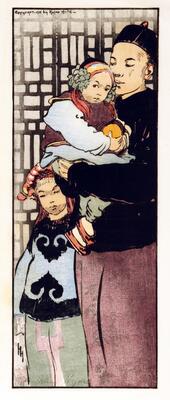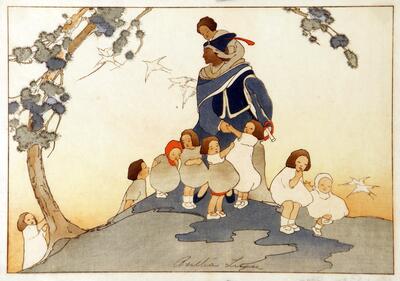American Orientalist art at the turn of the 20th century
America Encounters Asia in Art
When the UM Alumni Memorial Hall opened on May 11, 1910 it hosted the Exhibition of Oriental and American Art. The catalogue to the show stated, "The exhibition herewith shown to the public, although of a somewhat composite nature, is divisible into two main sections, Oriental and American art. While at first glance these may seem antipodal in nature, a closer study will show disclose striking bonds of similarity." By exhibiting the art together, Oriental and American Art demonstrated the encounter between understandings of Asia and America in art and how this shaped artistic practices in the early 20th century.
The Exhibition of Oriental and American Art and the art in this resource represents what David Brody has called "American Orientalism," which describes the ways that concepts and ideas of Asia are constructed in American culture. William Titcomb's poster for the Exhibition of Oriental and American Art demonstrates America's interest in representations of Asia in the late nineteenth and early 20th century. The exhibit's "Oriental" category encompassed Chinese and Japanese art. The exhibition was organized by Charles Lang Freer and others who collected and studied "the Orient" at the turn of the 20th century.
America and much of Western Europe developed an interest in Asian art during the mid-19th century and early 20th with the reopening of trade between Japan, the Boxer Rebellion and the enforcement of an open door policy with China by the West, and American imperial colonialism in the Philippines. Asia, or "the orient" to the American occident, encountered US cultural production to shape it and be shaped by it as well. While audiences and collectors would become interested in Asian art, Western artists like James McNeil Whistler and Van Gogh would adopt methods, techniques, and aesthetics from Japanese art.
In UMMA's collection, the color etching and woodblock prints of Helen Hyde and Bertha Lum are emblematic of American Japonisme in early 20th century graphic art. Hyde was born in Lima, New York in 1868 and lived mostly in Oakland, California. As an American printmaker who trained in the US and Europe, she lived in Japan between 1899 and 1914 where she would pursue her interest in Japanese woodblock printing. Japanese woodblock printing techniques differ from Western approaches through the use of water-based inks allowing for more control over the coloring of the print. The subject of most of Hyde's prints were East Asian women and children. For example, "Blossom Child" and "In the Holiday Clothes" from the UMMA collection show Hyde's innocent and playful illustrations of Asian women and children. Another American trained printmaker to adopt Japanese woodblock techniques was Bertha Lum. Born in Iowa in 1869, Lum received her art training at the Art Institute of Chicago and, like Hyde, would also study woodblock techniques in Japan, which are demonstrated in "Pied Piper." Both of these artists helped cultivate American Japonisme and color printing at the turn of the 20th century.
Part of 11 Learning Collections
<p>Chitra Ganesh' Takeaway</p>
4 Links
Created For
K-12 EducatorK-12 Student
Museum Visitor
UMMA Docent
UMMA Staff
University Faculty
University Student
Rate this Resource
AVG: 0 | Ratings: 0
& Author Notes
All Rights ReservedLast Updated
June 28, 2017 10:27 a.m.Report
Reporting Policy





